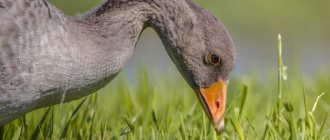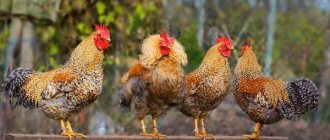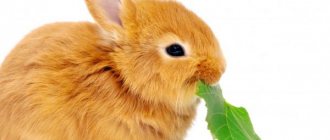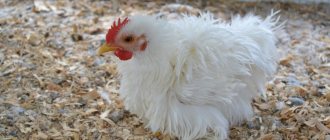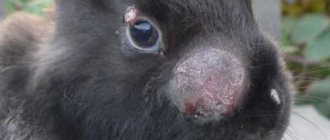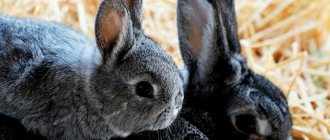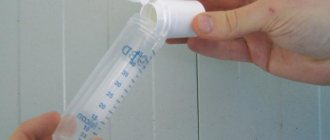Among the pathologies to which rabbits of all ages are susceptible, a large group consists of neoplasms of various etiologies. Most often they look like lumps and can be either an independent disease or a symptom of other infectious diseases. And in order to recognize them in time, the owner needs to know what tumors rabbits have and what are the reasons for their appearance.
Tumors and their classification
Tumors in rabbits (as in most animals) are formed due to the uncontrolled proliferation of tissue in which the genetic apparatus is disrupted. As a result of this disorder, the cells become larger and a lump appears.
All neoplasms in rabbits are divided into two groups depending on their morphological characteristics and ability to progress: benign and malignant tumors.
The main signs of benign tumors:
- the possibility of differentiation of cells from which the neoplasm is formed;
- small sizes;
- lack of germination into blood vessels and nearby tissues;
- slow growth;
- absence of metastases;
- painlessness.
Benign neoplasms do not have a general negative effect on the body of rabbits until they begin to put pressure on adjacent organs and interfere with their normal functioning. These include invaginal hernia. Groin swelling in male rabbits is usually treated by castration.
Important! Under the influence of provoking factors, benign tumors in rabbits can turn into malignant ones.
Signs of malignant tumors in rabbits:
- lack of resemblance to the tissue from which they begin their development;
- rapid infiltrating growth;
- cellular and tissue atypia;
- formation of metastases.
Unfortunately, many malignant tumors in rabbits have the ability to recur. Therefore, after treatment, it is necessary to regularly examine your pet in the clinic.
Abscess on a rabbit's neck
The main reason for the localization of a purulent tumor on the neck is a rabbit bite from a cat or dog. A fresh bite is difficult to diagnose. If you carefully touch and examine the skin, you can see four symmetrical points. Even if you burn the wounds with brilliant green or iodine, after the wound quickly heals, an abscess will develop at the site of the bite. Sometimes an abscess in the neck can be associated with a bacterial complication of the chronic form of myxomatosis.
Photo. Ripe abscess on the neck of a rabbit
The most common tumors in rabbits
Most often, bunions appear on the neck, head and stomach of rabbits. Although during examination and palpation other parts of the body should not be missed.
Infectious fibromatosis
Viral fibromatosis of rabbits in adults is caused by the formation of connective tissue growths under the skin and mucous membranes. In newborn rabbits, the disease manifests itself as a generalized lesion of almost the entire surface of the skin.
The causative agent of fibromatosis is transmitted through the bites of blood-sucking insects. Young animals are most susceptible. As rabbits age, their resistance to this virus increases.
The incubation period of the pathology lasts 2-3 days. After this, ovoid dense bumps appear under the skin on the body of adult rabbits, the diameter of which after a week is 3-4 cm. They become hemorrhagic and, as a result of necrotic processes, gradually become covered with scabs.
After about 2 weeks, the tumors develop back, and soon scars remain in their place. In some individuals, the causative agent of fibromatosis provokes the development of conjunctivitis, which is accompanied by the formation of small round bumps on the eyelids.
Throughout the entire period of the disease, the general condition of adult rabbits remains stable. But in rabbits, multiple tumors cause exhaustion and lead to death. In isolated cases, the bumps resolve on their own, and the babies recover.
For infectious fibromatosis, symptomatic treatment is carried out. Sick pets are isolated from healthy animals, and the cages are disinfected.
Breast adenoma
A lump on a rabbit's belly may indicate the development of a mammary adenoma. It is the most common form of neoplasm. This is due to good blood supply to this area and the speed of metabolic processes, which predispose to accelerated uncontrolled cell division.
An adenoma is a benign tumor that is enclosed in a capsule. It can be easily felt and rolls under the fingers, which is not typical for malignant neoplasms. An adenoma can take the form of either a convex soft lump or a hard, flat prominence.
Benign tumors of the mammary glands in rabbits are surgically removed if they do not affect the lymph nodes and vessels. To clarify the nature of the neoplasm, histological studies are carried out.
Important! To avoid the possibility of relapses, a veterinarian removes the entire mammary gland, and not just the damaged area.
Rabbit diseases - symptoms
Such dangerous diseases of rabbits as: myxomatosis, tularemia, coccidiosis, conjunctivitis, spirochetosis, lice, infectious mastitis can be dangerous for people. A person can become infected with them through contact with infected animals.
Myxomatosis
It is characterized by the appearance of small tumors that can unite into one common tumor. The main places of localization of mixots are: nose, mouth, eyelids, ears, paws, tail, genitals. Additionally, inflammation of the membranes of the eyes occurs. In the acute phase, the head swells and red spots appear on the skin. The ears drop down and their size increases. As the process progresses, conjunctivitis occurs. The eyes begin to fester and the eyelids stick together. There may also be pus-filled areas in the nose. At the site of tumors, necrosis appears - dead tissue. Rabbits' breathing becomes unclean and wheezing. The carriers of this disease are arthropods. These could be lice, fleas, dog beetles, and mosquitoes. They enter the cage through food and animal care items. It appears a week after the insect bite. As a rule, all individuals become ill.
Tularemia
The causative agent is cocci. Under the influence of elevated temperatures and disinfectants, the virus instantly dies. Able to survive at low temperatures and lack of moisture. Most often it affects young animals. In the wild, rodents suffer from tularemia. Insects transmit the infection through blood through bites. These include mosquitoes, ticks, lice, fleas, bedbugs, and flies. Transmitted by airborne droplets, transmission, and nutrition. Rabbits get sick mainly in the summer and spring, when rodents migrate. When the first signs of disease appear, you should immediately call the veterinary center. Here, you will be advised by specialists, and it will be absolutely free. If you understand that you cannot manage without calling a veterinarian at home, then in this case you need to make an application by phone and a specialist will look at your pets at home.
This disease has a number of symptoms:
- Fever;
- Enlarged lymph nodes;
- Body paralysis;
- Pathology during pregnancy and miscarriages.
The main source of infection is food and water. Airborne route of infection. It can occur in a latent form without obvious signs. In the acute phase, a cough appears, they begin to breathe with difficulty, and purulent skin lesions develop. Rabbits develop strong immunity to this pathogen. If an animal has been ill once, then infection is excluded the next time.
Conjunctivitis
The mucous membrane of the eye becomes inflamed. There are two forms of development of this disease: catarrhal and purulent. There is swelling of the eye, tearing, and redness. Further, in the absence of symptomatic treatment, purulent conjunctivitis appears. Complications may include clouding of the cornea, the appearance of cataracts and ulcers.
Coccidiosis
Signs of the disease:
- Decreased appetite
- Weight loss
- Pale mucous membrane
- Jaundice
- Diarrhea and bloating.
Animals often die. As a preventive measure, iodine diluted in water is used. Take 20 mg of 5% iodine per 10 liters of water and feed the animals for 5 days. Then skip 5 days and repeat the procedure again.
Infectious mastitis
Lactating females are susceptible to the disease. It is caused by staphylococci, penetrating into the mammary glands. This type of microorganisms is classified as opportunistic. They live on the body of animals. Once in a favorable habitat, they begin to multiply vigorously, causing mastitis. There is redness and hardening of the udder. Then pustular formations and small cracks appear. Damage to one mammary gland leads to disease in the remaining glands.
Spirochetosis
The carrier of the infection is a sick rabbit. When mating with a healthy individual, the latter becomes infected. Redness and swelling appear on the genitals and anus. As the disease progresses, discharge from the genitals is observed and small ulcers form. This pathogen does not affect the general condition. But if such animals give birth to offspring, then, as a rule, they are weakened. Females rarely give birth to young rabbits. Sometimes the hair falls out. Males develop blisters on their lips. It is necessary to conduct an examination of the animal. At the veterinary center, the rabbit will have the affected area of its skin scraped. After laboratory confirmation of the diagnosis, the doctor will prescribe a treatment regimen.
Lice
This parasite develops only in rabbits and hares. When infected, the following signs appear:
- Loss of appetite;
- Bite marks are visible on the skin;
- Dry skin where scratched. Crust formation.
Other pathologies that cause bumps in rabbits
Bumps on the ears, groin, neck and eyes of a rabbit may indicate the development of purulent inflammation, cancerous tumors, bacterial and viral pathologies.
Note! Sometimes owners notice that a massive double chin or goiter begins to grow on the rabbit’s neck. This is most often associated with obesity. However, there are breeds for which such fur folds are the norm.
Abscess
An abscess in rabbits is a cavity that forms as a result of acute purulent inflammation. Gradually, a connective tissue capsule forms around the source of inflammation. If it opens into the external environment, then it is enough to free the wound from pus and treat it with a disinfectant. However, the abscess can open inward on its own. In this case, purulent exudate enters the bloodstream and causes sepsis, which can cause death.
Note! Abscesses can become chronic, with periodic relapses in the form of fistulas.
There are several causes of abscesses in rabbits.
| Clinic | Localization location | Causes |
| Superficial lump in the skin | Head area, neck, back, scrotum, mammary glands | Injuries during fights and bites, punctures with sharp objects |
| Limbs | Obesity, unsanitary conditions, injuries from sharp edges of hay and straw | |
| Multiple abscesses on different parts of the body | Infectious processes in the body | |
| Subcutaneous abscess affecting underlying tissue | Head area, neck, back, scrotum, mammary glands | Deep bites or punctures, spread of infection through blood and lymph |
| Cheeks | Injury due to improperly grown teeth or excessively sharp edges | |
| Lumps in subcutaneous tissue and muscles | Place of IM or SC injections | Administration of oil-based medications, non-compliance with antiseptic rules during injections |
| Large abscesses accompanied by skin necrosis | Cheeks, upper and lower jaw | Injuries to the soft tissues of the oral cavity from sharp objects, parts of plants or edges of teeth |
| hard lump | Intermaxillary space | Dental diseases |
| Multiple painful abscesses combined with ulcers, lameness | Limbs | Introduction of pathogenic microflora through damaged skin of the extremities |
Also, multiple abscesses can be a sign of a chronic form of pasteurellosis in rabbits.
Factors predisposing to the appearance of abscesses in rabbits:
- unsanitary conditions of detention;
- abrasive bedding;
- crowded content;
- helminthiases;
- congenital and acquired immunodeficiency conditions;
- unbalanced feeding;
- frequent stress.
Classic symptoms of abscesses in rabbits:
- hyperemia;
- increase in local temperature;
- pain syndrome;
- swelling;
- fluctuation at the formation stage;
- swelling of surrounding tissues.
After the formation of the capsule, the temperature normalizes, hyperemia, swelling and soreness disappear. During this period, the abscess can be opened. But you should not do this yourself, as there is a risk of capsule rupture and blood poisoning. Also, if antiseptic treatment of the wound cavity is insufficient, relapses may occur.
Flux
Flux in rabbits is a type of abscess in which purulent exudate accumulates near the root of the tooth and looks like a lump on the gum.
The causes of this pathology:
- oral injuries;
- tartar;
- anomalies in the structure and growth of teeth.
With flux, the following clinical symptoms are observed:
- refusal of food;
- loosening of affected teeth;
- unpleasant putrid odor from the mouth;
- avoiding contact with a person due to pain.
If treatment is not carried out in time, pus can enter the bloodstream, cause sepsis and cause death.
Myxomatosis in rabbits - nodular form
This form of the disease is milder and, as a result, curable.
The survival rate with timely initiation of treatment is about 50 percent of all sick animals.
The meat of cured and surviving rabbits is edible.
The clinical picture of this form of the disease looks like this: small nodular formations appear on the body of rabbits, especially clearly visible near the eyes and on the surface of the ears. Then purulent conjunctivitis develops. Over time, other symptoms appear - runny nose, wheezing, refusal to eat. The duration of myxomatosis in the nodular form is about one and a half months. If you actively support your rabbit with appropriate therapy during this time, there is a good chance that he will survive and make a full recovery. This infection usually leaves no traces on the animal’s body; only small scars are possible on individual parts of the body.
More on the topic: Peculiarities of breeding breeding rabbits
What could be hiding under the bump?
Let's take a closer look at what dangers a rabbit's bump may indicate.
Abscess
An abscess is a suppuration that occurs at the site of a blow or injury in active rabbits. No matter how hard the owners try, it is impossible to maintain sterile cleanliness in the rabbitry all the time, which means that pollution and bacteria enter the damaged area, causing it to rot.
The animal’s natural immunity tries to cope with the threat, but if the abscess grows over time, then the attempts are unsuccessful.
In fact, an abscess bump protects the body up to a certain point, accumulating pus and toxins in itself, as if in a capsule. However, if timely treatment is not carried out, its membrane will burst and blood poisoning will begin.
Abscess in rabbits most often occurs due to:
- dental diseases (on the chin);
- insect bites;
- skin punctures, cuts by grass stems, sharp stakes, fences.
You can identify an abscess if you look closely at the symptoms. In a rabbit with an abscess:
- when palpating with your fingers, a slightly movable lump is felt;
- most often such a lump (no larger than a grape) is found under the jaw, at the groin or near the base of the ears;
- apathy and lethargy in the later stages;
- loss of appetite and then weight;
- scratching on the body. As the abscess itches, the rabbit will begin to rub against surfaces and corners to relieve the itching.
Apathy in a rabbit is one of the symptoms of an abscess.
Flux in rabbits is an infectious disease that occurs when the oral cavity is damaged and manifests itself in the form of tartar formation. It is this, like a lump, that can be felt from the outside of a rabbit's face.
The following symptoms accompany flux:
- lack of appetite in the animal;
- poor sleep;
- teeth may begin to loosen;
- a putrid odor appears from the mouth;
- sometimes salivation increases;
- The rabbit often does not allow his jaws to be touched to avoid pain.
Lack of appetite in a rabbit as a symptom of gumboil
Tumor
By its nature, a tumor is a pathology that occurs due to uncontrolled cell division in tissues or organs, forming tumors of various shapes and sizes. They usually grow on the skin or internal organs.
Such “bumps” are divided into two types:
- benign;
- malignant.
They differ from each other in several ways:
- the former are much smaller in size than the latter;
- benign ones do not grow;
- there are no metastases on them.
However, it is rare for a non-specialist to be able to tell the difference at first glance, so it is worth contacting a veterinarian as soon as possible. Only laboratory tests can give an accurate answer about the benign quality of the formation.
In addition to the presence of the lump-tumor itself, the problem may be indicated by:
- a sharp decrease in the rabbit's weight;
- pet’s refusal of food and water;
- dull coat;
- pallor of the mucous membranes and skin;
- breathing problems;
- cardiopalmus;
- liquid discharge from natural orifices.
What is a bump
Whether in a person or an animal, a lump is a neoplasm in the form of a rounded bulge, a tubercle that appears on the skin or in the body. It is most often hard to the touch, usually without hair or with sparse hairs. There are many reasons for the appearance of cones, and treatment is prescribed depending on them.
For diagnosing a disease, the place where it arose is of no small importance.
Read about how to treat: cysticercosis, stomatitis, pododermatitis, flatulence, viral hemorrhagic disease, conjunctivitis and pasteurellosis in rabbits.



